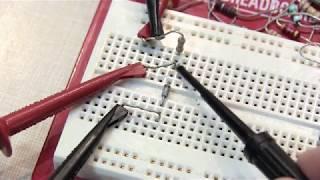
#289: Back to Basics: Zener Diodes - How to Use | Applications | not all created equal
Комментарии:

Sums up Zener in all aspects. Enjoyed it,
Ответить
As you implied, the temperature stability depends on the break through voltage.
The 5.2V Diodes are very stable as they tend to have a combined coefficient of zero.

Why don't they break? Something to do with the length of the depletion region?
It is amazing that they can take much power without changing or burning.

Nice lesson once again, especially about the avalanche process. My experience with "standard" zener diodes that they typically have a wide zener voltage tolerance, maybe even +/-10%. What I have noticed on your curve tracer that the forward part (first quadrant) also have a very steep (90 deg) curve, as in a lot of theory books that draw more a 45 deg curve. The 90 deg is more realistic as we know that a forward biased diode has a very little resistance and that the current would indeed sky rocket 🙂
Ответить
Awesome...cheers.
Ответить
Aha! So the balancing of the positive and negative temperature coefficients is what's used to make the temperature-stable Zener that you use as a voltage reference in your 50 microamp current source, handy for calibrating Simpson 260's! Love it!
Ответить
Again, the best explanation I have ever had. Thank you
Ответить
off topic: What paperwhite tablet are you using?
Ответить
This is the best tutorial on Zener Diodes I have ever seen.
Was going to rate it 10 out of 10 then I saw you included the notes as a PDF.
So now it is 11 out of 10. Thanks so much for the perfect demonstration.

Thank you Sir. Terrific keep it up.
Ответить
Great work, thank you. What is the pad that you're drawing on, please? Is that an electronic tablet?
Ответить
Great, great...
Ответить
Out of the regular, cheap Zener diodes, the ones that have the lowest temperature coefficient are those rated for 5.6V. In them, the contribution of both effects (Zener and avalanche) is more or less balanced and the temperature coefficients largely cancel each other. So if you need the most temperature-stable Zener diode as a reference and don't want to pay for special parts, a 5.6V one is your best bet.
Ответить
👍👍👍👍👍
Ответить
Sir germanium diode about plz
Ответить
Incredible video. But does this mean that the schematic symbol of zener diodes below 5 or 6 V will be opposite to the usage of an avalanche one above that? (because in the video you still shows the P-N junction like a normal diode would be, for the avalanche style, with the difference being very lightly doped in comparison)
Really interesting stuff!!!

Do a video lesson about precision voltage reference IC chips because they have a zener diode but also they use an IC op amp to compare the voltage. If you look at the datasheets of various precision voltage reference components because they can be used as a voltage regulator. I'm not sure what the capacitance loading has to be before the output pin starts to be unstable
Ответить
Excellent!
Ответить
Can you explain how your equipment works that traces the two curves at once? I’m confused on what I’m looking at. You’re tracing the positive voltage and negative voltage lines at the same time, I think I’m lost on what it means to be reversed biased
Ответить
Thanks Alan,next please show us how to make a random noise generator out of them!
Ответить
Very much appreciate you taking the time to show a demonstration rather than simulations and drawings.
Ответить
this little difference is never shown on books i read, thanx!
Ответить
I love your videos, you do such a great job at presenting the information.
Peace and blessings 🙌

U teach like a pro please keep up this work for our sake
Ответить
still learning! :)
Ответить
Thanks again AEW. For me, not being technically educated, your explanations are very clear and to the point. I keep all your info printed on my desk and work with it. Keeps me going in the hobby on my age.
Ответить
Outstanding vid and teaching. Zener diodes are often used in the design of Intrinsic Safety, where a circuit has to be used in a Hazardous location and the voltage MUST be controlled to never go beyond a certain amount.
Ответить
Excellent explanation of the zener diode thank you very much
Ответить
Well I learned quite a bit... 😀
Ответить
the sharpness difference was striking, when you have an electric spark from a capacitor you get an extremely sharp turn on that can be easily compared to the avalanche effect imo.
If you wanted to create a good electronic analogy to a spark gap, an avalanche diode combined with a power transistor should do the job well.

Hi Alan, you could have shown the temperature co-efficient impact on the IV curve by heating up and cooling down the diodes.
Ответить
Need a circuit solution? Why not use this follow androidcircuitsolver on google
Ответить
above all praise, 73
Ответить
Holy breakdown Batman that was an absolutely fantastic video
Ответить
Who knew you could almost base an entire physics career on diode design, application and theory.
Ответить
Very well done. Thank you.
Ответить
I just discovered your channel few days ago, looking how to re-calibrate an old Tek 465 I purchased from eBay. I had this scope on my bench at work, in Romania, from 1988 to 1995, a great scope. You're a very talented teacher. Thank you for everything you do. Myself been a HAM since 1985, 73s Catalin YO3FCU.
Ответить
Now I know how they work :)
Be great to see a voltage regulator circuit with a Zener in it.

Big love to my teacher for showing me this channel, these videos are really helpful, thanks ^^
Ответить
Alalanche diodes literally drop of a cliff as your curve tracer shows.
Ответить
When you work for a company which produces instruments whose functions are based on a zener reference diode's stability, you appreciate the cost of a GOOD diode when compared with a "blah" diode. LOL de KQ2E
Ответить
Now I know why i have seen zeners in series as a reference in older schematics they are trying to cancel the opposite temperature Coefficient for a more stable reference... love your vids Allan one of the best channels on yt.. your knowledge and aptitude for passing it on is really commendable.. you take the time to pass on with no real reward other than the knowledge you have helped others.. our society grows great thanks to folk of your calibre Thank you so much
Ответить
thanks for the video. very well explained! no questions remain to be asked :) now please do a part 2 on how to use voltage reference circuits using cheap npn bjt/mosfet using zerner or other techniques. thank you very much!
Ответить
Thank you for doing these videos you are an excellent teacher! Explained in a clear and concise manner.
Ответить
never seen a 200v zener i dont think These are really around
Ответить
Since avalanche diodes have sharper turning point, is there any benefit of using regular zener diodes? Besides balance out the temperature coefficient
Ответить
Excellent video sir! This is a very insightful video about the zener diode. With the illustrations on the curve tracer made it even more clear. Thank you very much for this lesson. I like your videos a lot, you are an excellent teacher.
Ответить
amazing as usual
keep forward please

That curve tracer, what a beautiful piece of equipment, and the old Tektronix logo are lovely. Looks like someone really took good care of that unit. Great video as always, thanks.
Ответить
nice review
Ответить








![NaVi vs. Spirit - Map 1 [Ancient] - IEM Katowice 2024 - Group A NaVi vs. Spirit - Map 1 [Ancient] - IEM Katowice 2024 - Group A](https://invideo.cc/img/upload/c1NVX2hKVktuRzk.jpg)
















